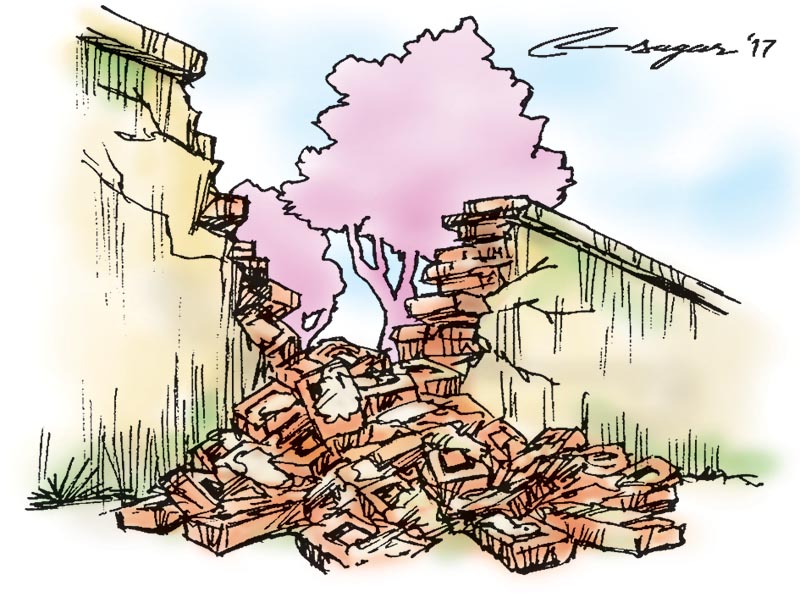Boundary walls: Multi-hazards
Roads are the immediate infrastructures beside the boundary walls, thus in the case of boundary wall collapse the evacuation planning as well as rapid response and rescue would be marred
It was a drizzling monsoon night when I was suddenly woken up by a thumping collapse of my neighbor’s boundary wall. The same wall had some serious cracks due to the 2015 Gorkha earthquake and I was imagining the collapse way before this monsoon.
However, although people are dedicated to providing boundary walls for their properties, what is really happening is the current constructions of boundary walls is not compatible with the demands and aspirations as such walls do not consist of any multi-hazards resilient measurements.
Once the boundary walls and other walls used for non-structural purposes are exposed to loads, there might be a case of collapse due to following shaking even due to minor shaking or water infiltration and so on. Presently, most of the urban and peri-urban areas of Nepal now follow reinforced concrete construction practice and virtually all such buildings consists of non-engineered boundary walls.
During the 2011 Eastern Nepal earthquake, the wall collapse in Lainchaur claimed human lives. Weightier was the case during the 2015 Gorkha earthquake that caused many casualties due to collapse of boundary walls. Boundary walls are usually close to sidewalks and public movement is inevitable in such areas during earthquakes and other hazards.
However, due to lack of seismic provisions and considerations, neither such walls are constructed to resist the torrential rainfall related failures and every year, like in my neighbor’s case, hundreds of cases occur and sometimes the damage pivots casualties as well. Due to privacy and boundary issues, boundary walls are being built more in recent decades. Most of the building construction strategies lack multi-hazards resilience and a larger fraction of consideration is provided to earthquake forces only. This is ultimately disregarding the fact that even non-structural constructions could claim lives and losses of properties. As in the case of the 2015 Gorkha earthquake, a single brick could claim life, however, Nepal’s priority hasn’t reached up to consideration of non-structural members with the same degree of seismic safety considerations.
Casting well designed beams and columns do not solely assure seismic safety. A thorough consideration is required to avoid casualties that would occur from the collapse of non-engineered or poorly engineered building as well as boundary components.
Being a multi-hazard prone country, Nepal could face several other disasters either independent or cascading ones and the non-structural members like boundary walls would face the severe damage level as such walls would be already triggered with previous events and no substantial repairs would have been provided.
For instance, torrential precipitation and storm surge could also knock down the boundary walls affected by the Gorkha earthquake. The most important aspect is exposure of such walls under several extreme hazards like earthquakes, floods and others. So it is time to rethink over the boundary walls across the urban and sub-urban neighborhoods.
Around the valley, very high, distorted, cracked and deteriorated boundary walls are rife. Most of such walls existed before the main shock of 25 April 2015 and are continually shaken by the aftershocks until now. Thus, the exposure has undoubtedly affected the integrity of the walls.
The outcome would be disastrous as the walls are barely homogenous now and even the vibration from a moving vehicle may lead to their collapse. Such collapse may not only affect the pedestrians, but the impact would be also propagated to the moving vehicles and the losses would be detrimental.
The single-leaved brick masonry wall is the most common boundary wall type practiced in Kathmandu Valley. No proper seismic considerations were provided to such walls constructed before the Gorkha earthquake. Thus the only solution is to replace the walls with adequate seismic provisions.
To this end, the walls should be strengthened as the seismic safety should be limited to the occupants and the people and vehicles beside boundary walls should also be considered. Some efforts were seen in the case of public buildings like the Supreme Court, however, reaching up to residential level has still a long way to go.
The current building construction system should consider seismic provisions to the boundary wall too. To do this, legal regulations should be formulated first and then implementation should be strictly checked. Roads are the immediate infrastructures beside the boundary walls, thus in the case of boundary wall collapse the evacuation planning as well as rapid response and rescue would be marred.
On the other hand, emergency services like ambulances and fire brigades would be also obstructed due to the rubble and that may lead to additional casualties and property loss. An uninterrupted response should be assured to downsize the effect of natural hazards, however, there is a huge possibility of obstruction from the boundary wall collapse in the case of future disasters. Accounting boundary walls as integral component of building systems and considering thorough seismic as well as other hazard safety regulations may save lives and property during the calamities.
Gautam is a Researcher in Structural Earthquake Engineering






